Testing the Bosch Edgerunner
This long-tail cargo bike is really smooth with many advantages and few drawbacks.
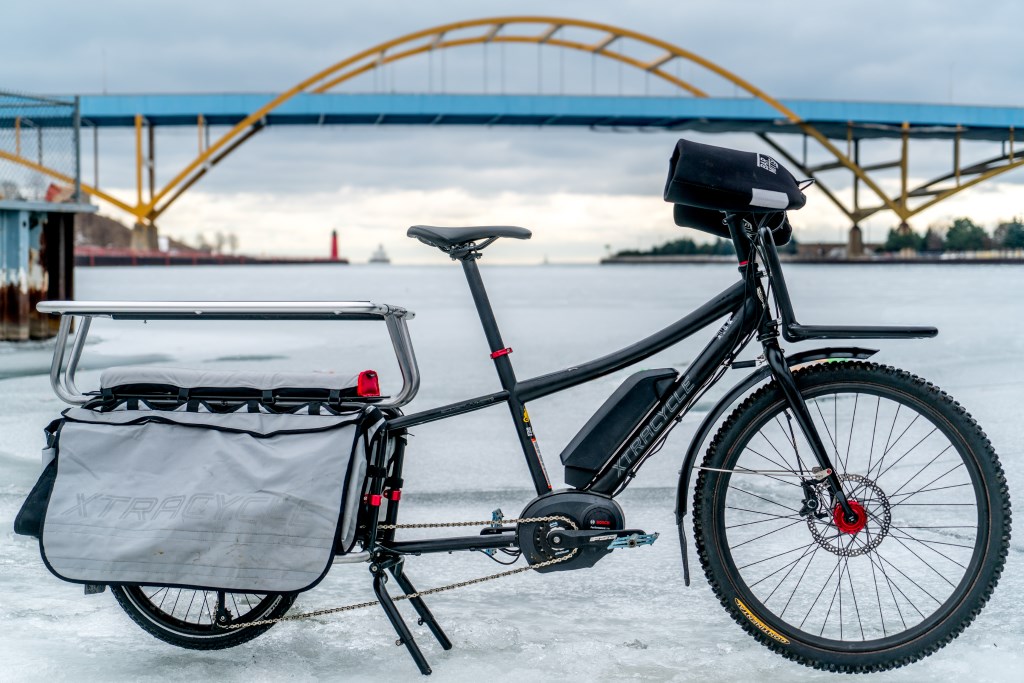
Studded tires on the Bosch Edgerunner made for safe, fast commutes. Coast In Bikes is the only shop in town that stocks 20 inch studded tires for the rear wheel.
When Tristan and Carolyn at Coast In Bikes told me they had an Xtracycle Bosch Edgerunner 10E in stock, I immediately asked if I could borrow it for a weekend to review it. That was back in January, but I have been so busy that I am only just now getting to the write up.
Before I bought my electric-assist Yuba Spicy Curry earlier this summer, I inquired about purchasing a Bosch Edgerunner. Coast In Bikes did not have one in stock at the time and their rep from Xtracycle could not tell me when they would be available. When I commit to dropping this kind of coin, I need to strike while the desire is hot. If I wait too long, a water heater goes out at home or something else arises and suddenly I don’t have the scratch for an expensive bike. So I ordered the Yuba Spicy Curry instead because it was available.
With nearly 3,000 miles on my Yuba, I know it well by now. I am happy with my purchase, but I always had that “what if” thought about the Bosch Edgerunner. Thanks to the good folks at Coast In Bikes, I no longer have that nagging thought.
Ross Evans of Xtracycle is arguably the modern inventor of the long-tail cargo bike. Twenty years ago, Evans, a Stanford engineering student, welded up his first long-tail cargo bike in Nicaragua with the goal of producing an inexpensive attachment to regular bikes that could help farmers pedal their produce to market. When Evans got back to California, he founded Xtracycle, now one of the most well-know long-tail cargo bikes.
So Xtracycle knows their long-tails. They have developed lots of great, time-tested accessories and proven they know how to build a bike that rides well and holds up to heavy loads. While many couriers and some families prefer long-john-style, front-load cargo bikes like the Bullitt, I often sit on the back of a bike to take photos of other people riding behind me, so a long-tail makes the most sense for me. The only reason I opted for the electric assist is that I was running out of friends who were willing to pedal me around on photo shoots.
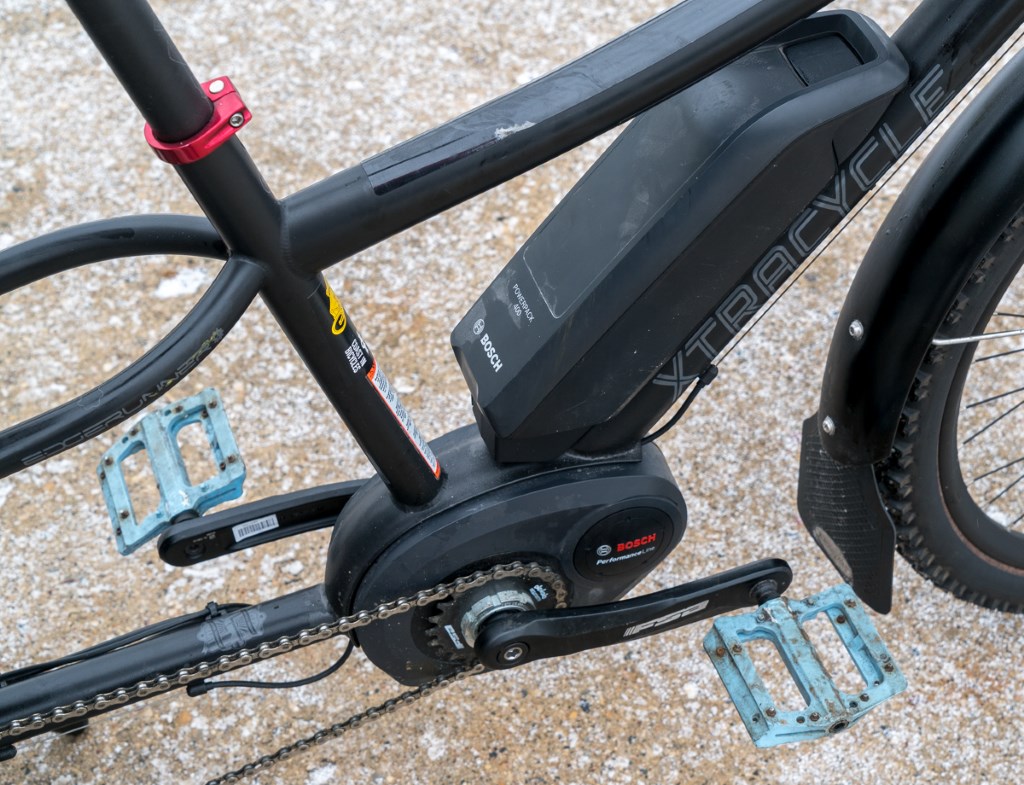
Mid-drive e-assist bikes are the way to go in my opinion because they let you run the power through the gears in the back. Hub motors need to be more powerful since they are direct drive.
Having said that, I am now a huge fan of electric assist. To make it clear to those who have never tried one, the assist on the Bosch (and my Yuba) only works when you are pedaling. There is no throttle, just four different levels of assist: Eco, Tour, Sport and Turbo to change what level of assist you want pedaling. With the Bosch 350 Watt mid-drive motor and the power set to Turbo, it is easy to pedal along at 19 miles per hour on the flats, even with a heavy load. I was able to go up hill at 16-17 miles per hour without much trouble at all. Legally, the assist has to cut out at 20 mph. I found it cut out just above 19mph according to the speedometer on the control display. Either way, that is probably fast enough to drop your friend on a carbon fiber racer bike going up a hill.
The first thing I noticed about the Bosch drive is how smooth it was. There is no jerking, no surging, and no clunks when shifting gears. You definitely feel it when helping you along, but the system is certainly dialed in. In contrast the Currie Tech system on my Yuba Spicy Curry does surge a bit and clunks some when shifting gears while pedaling.
The other thing I noticed was the narrower Q factor on the Bosch compared to my Yuba. Q factor (coined by Grant Peterson while at Bridgestone) is basically the distance between the pedals, which affects how far apart your feet are from each other when pedaling. On a regular road bike, your feet are closer together than on a fat bike for instance. On a bike with a mid-drive assist, the pedals are outside the motor, which is wider than a normal bottom bracket. This feeling takes a bit of getting used to if you ride a regular bike a lot. The Q factor on the Bosch was noticeably lower than on my Yuba. That means the Bosch Xtracycle will immediately feel more natural to pedal for most people. Now it is still wider than a regular road bike, so don’t think Grant will be giving Bosch a rave review, but it is better than the my Yuba Spicy Curry.

Although the range said 41 miles on Eco with a fresh charge, I was never able to get more than 30 miles out of a battery.
Battery life seems about comparable to the Yuba. The Bosch system comes with a 36-volt, 11-amp hour battery whereas the Currie Tech on the Yuba is a 48-volt, 8.5 amp hour battery. Both are lithium ion, of course. The Bosch battery takes about 3 1/2 hours to fully charge, but will charge to about 50 percent in 1 1/2 hours. The one thing I didn’t like about the Bosch was I had to remove the battery to charge it. That is not particularly difficult, but it is annoying since you will most likely want to charge it every time you stop.
Xtracycle claims you can get between 20 and 60 miles on a charge, but I was never able to get more than 30 miles out of it even on the lowest assist level. In fact as you can see by the photo, even set to the Eco level, the Range indicator told me I had a range of 41 miles with a full charge. Yuba makes similar range claims with their Curry, and I have not been able to get more than 30 miles out of a charge on my bike, either. Run either bike at a higher assist level and you are effectively down to a 20-mile range. That means I need to charge my bike at the office if I plan to ride it to any meetings or run an errand on the way home. Removing the battery to do that just adds to the annoyance. I don’t know why they don’t make e-assist cargo bikes with higher capacity batteries given they have a rated capacity of 400 lbs.
Ask Xtracycle or Yuba and they will tell you to buy a second battery for $500+. I think all cargo bikes should come with at least the option of a 15-20 amp hour battery. And since you have to charge the smaller batteries so often, they ought to build the charger into the bike so all you need is a regular cord. Hopefully those things will come in the second generation cargo bikes. You can already get those battery packs for aftermarket mid-drive systems like the Bafang. Perhaps the cold weather reduced the range of the Bosch, but I have a hard time imagining anyone could get more than 40 miles out of one charge even on Eco with an unloaded bike.
As for the rest of the Xtracycle, I have nothing but compliments. The accessories are all amazing. The front Porter rack that mounts to the head tube is great, but at $250 is a little on the expensive side for an OEM rack. The fenders are extra, too ($75). The rear Hooptie rack ($150), designed for kids, also fits two plastic milk crates perfectly. That is a serious bonus for grocery runs. The Carry All Cargo Bags (included) work really well and can carry a full weeks shopping for our family of three plus dogs, but the milk crates give you even more cargo space. The Edgerunner comes with the very sturdy double kick stand as standard (extra on the Yuba). Xtracycle redesigned their kickstand to make it easier to deploy when the back bags are loaded or you have the foot rests in.
Finally, the SuperNova designed e-bike light was just amazing. It is designed specifically to work with the Bosch system, and boy is it bright!
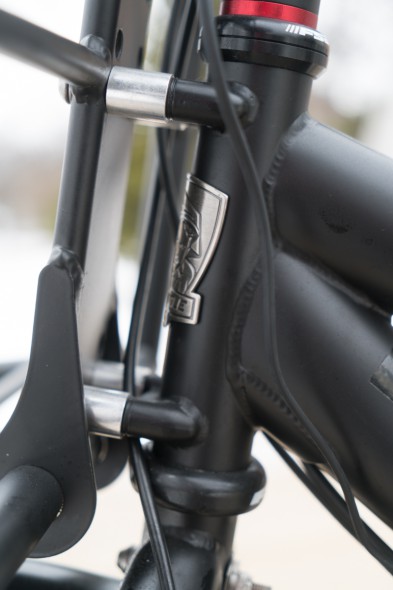
The front Porter rack attaches directly to the head tube, which means adding weight doesn’t affect steering.
At around $5,500 without any add-ons, this is a serious investment. That said, I know plenty of people who spend that kind of money on fancy racing bikes every couple of years. If you really want to replace car trips with bicycle trips, an e-assist cargo bike is a guaranteed way to do it. The ability to haul a bunch of stuff and get around at 15-20 miles per hour makes all the difference in the world. Since I got mine, I find I run way more errands by bike. And given that our family of three drivers shares one car, this seems a bargain.
For those who worry that they won’t get any exercise, studies have proven that e-assist simply gets you where you are going faster. You still expend the same amount of energy as you would on your regular bike, you just get where you are going sooner. In our modern, busy, 60-hour-work week lives, that is huge.
All-in-all, I have to say Xtracycle’s Bosch Edgerunner 10E has the most refined electric assist I have ever used. The controller is super easy to use and adjust while riding. The shifts under load are smooth and the bike doesn’t surge as much as other systems I have tried. And the maker’s years of experience show in the well-designed accessories for the Edgerunner. Truly, this is one of the most dependable electric assist cargo bikes on the market. I can’t wait to try the bike when things green up a bit to get some sunnier photos. Hopefully I will have time to share those with you before the snow flies again!
Bike Czar
-
Join a Bike Ride Under the Polish Moon
 Jun 1st, 2018 by Dave Schlabowske
Jun 1st, 2018 by Dave Schlabowske
-
9 Reasons to Join National Bike Challenge
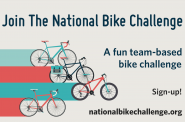 May 4th, 2018 by Dave Schlabowske
May 4th, 2018 by Dave Schlabowske
-
Biking Through the Mindoro Cut
 Apr 27th, 2018 by Dave Schlabowske
Apr 27th, 2018 by Dave Schlabowske


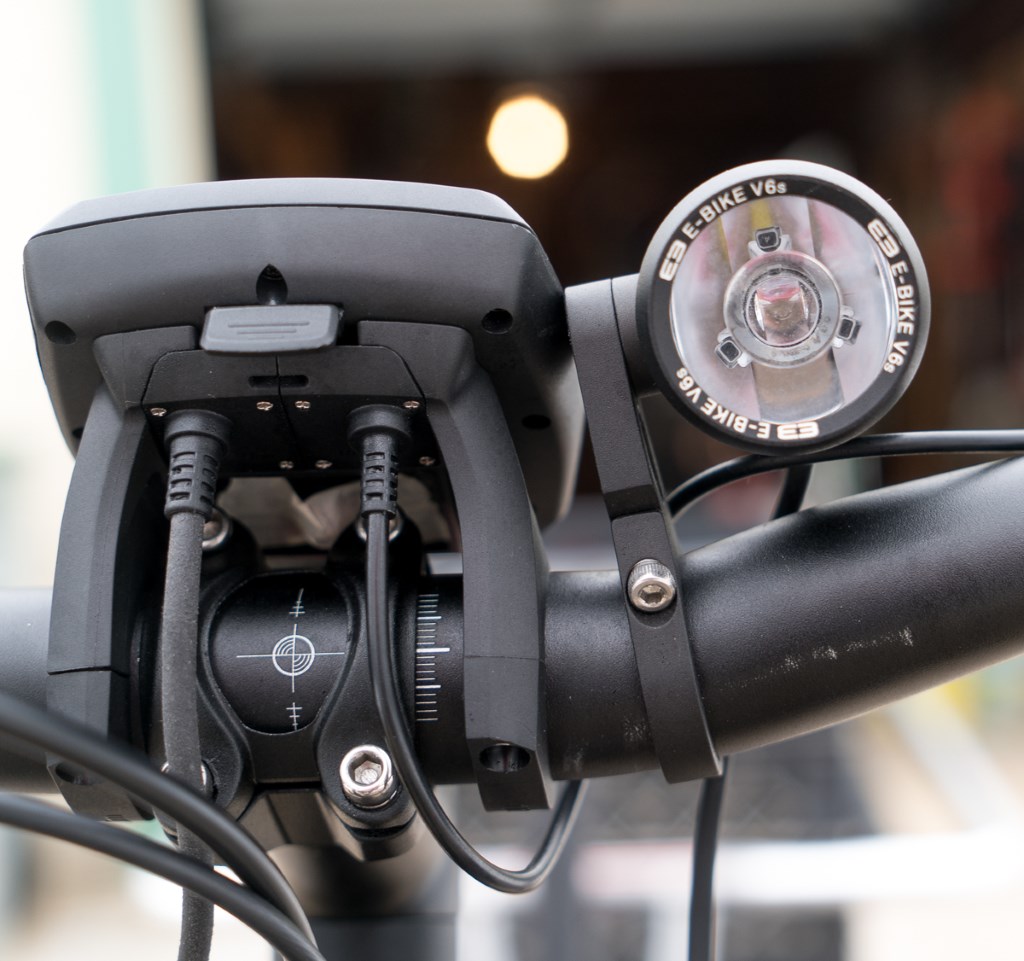
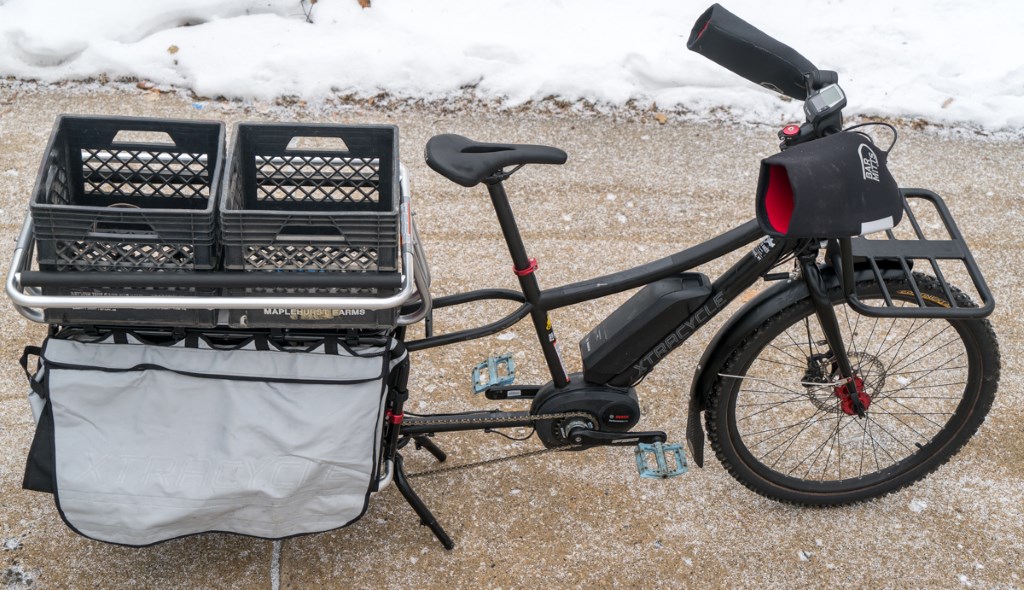




















I have also ridden this very same bike. It’s amazing how quickly you can get this heavy bike from 0-20 mph. What’s more amazing is how little effort is required.
I do have to call out bad science when I see it though. The link to “proof” that you use the same amount of energy is nothing but junk science. Watts is not a measure of power. Power is Watts * time. So even if a biker on this fancy two wheel car is generating the same watts as a normal biker, they are doing so for much less time and therefore using fewer calories.
D’nardo
As always when I get on the soap box I screw up…
Work = Watts * time. (Not power). But the point is it takes calories to do work and electric bike decreases the amount of work required to bike.
D’nardo